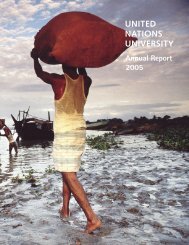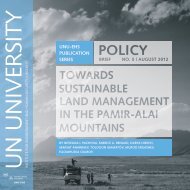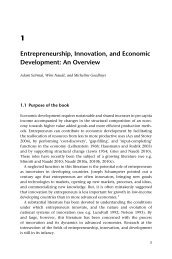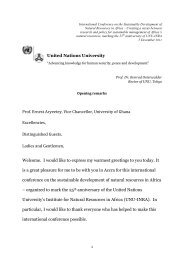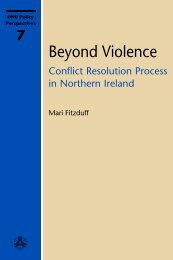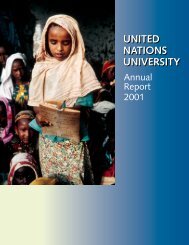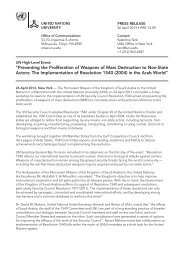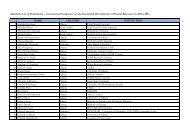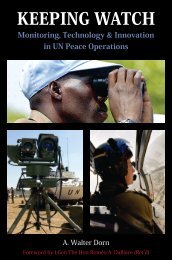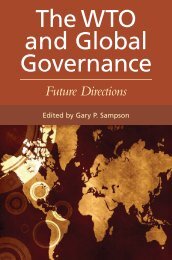Sample Chapter - United Nations University
Sample Chapter - United Nations University
Sample Chapter - United Nations University
You also want an ePaper? Increase the reach of your titles
YUMPU automatically turns print PDFs into web optimized ePapers that Google loves.
28 Yoshinobu Yamamoto<br />
other nations pursuing bilateral (with China) and multilateral policies<br />
that combine cooperation and competition.<br />
(iii) The use of institutions: Institutional balancing<br />
As part of this process, each nation acts on the basis of its own individual<br />
economic and security interests. Such actions are sometimes unilateral,<br />
sometimes bilateral and sometimes multilateral. There are several related<br />
issues in the context of the regional integration theories discussed so far.<br />
One is that the various cooperative entities and international regimes<br />
that have been created in the economic, political and security sectors will<br />
be used in various combinations for confidence-building and hedging<br />
(to provide against and check China’s opportunistic actions) as well as<br />
counter-hedging by China. Here, multilateral forums and institutions are<br />
combined with realism which may be called “institutional realism” (He,<br />
2009). As discussed in previous sections, there are a variety of multilateral<br />
regional cooperative entities, forums and institutions in this region.<br />
APEC’s 1994 Bogor Declaration, as mentioned above, set a goal of free<br />
and open trade and investment among its developed nations by 2010.<br />
With this in mind, the idea of an FTA for the entire Asia-Pacific region<br />
(an FTAAP) emerged in the second half of this past decade. One of the<br />
proponents thereof, C. Fred Bergsten, gives, to reiterate, the following as<br />
a major reason for an FTAAP: it would allow APEC members to avoid<br />
the problematic choice of whether to go with the <strong>United</strong> States or China<br />
(Bergsten, 2005). There are several debates within APEC about how to<br />
put together a future FTAAP; for example, at the 2010 APEC meeting in<br />
Yokohama, APT, ASEAN+6 and TPP were suggested as candidate parent<br />
organizations, but the EAS (which the <strong>United</strong> States and Russia were<br />
joining) was not suggested apparently because of Chinese opposition<br />
(APEC Leaders’ Declaration, 2010). Another security forum encompassing<br />
the entire Asia-Pacific region is ARF; as previously mentioned, the<br />
<strong>United</strong> States started taking an active role in ARF in 2009, and at times<br />
takes the lead in restraining China. There is also the EAS, which decided<br />
in 2010 to add the <strong>United</strong> States starting in 2011, and in the autumn of<br />
2010 the ASEAN Defence Ministers’ Meeting was expanded to create<br />
ADMM-Plus, encompassing the same ASEAN+8 countries as the expanded<br />
EAS. At ADMM-Plus, US Defense Secretary Robert Gates<br />
brought up the concept of “freedom of navigation” as a way of sending a<br />
warning message to China. Also, if TPP negotiations – which China is not<br />
a party to – go well (and if Japan joins), the result should act as a significant<br />
economic, political and security counterweight to China. Furthermore,<br />
many of the alliances that make up the US-centred hub-and-spoke<br />
network are being strengthened with China in mind. Meanwhile, China is<br />
continuing to increase its military expenditures (although this is probably<br />
simply an issue of military expenditures increasing in pace with GDP)




